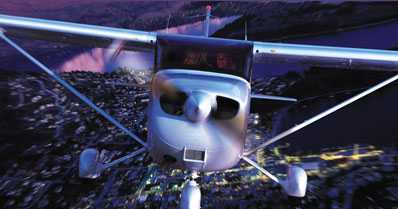"Heavy" Concerns About the Load Carried By This Aircraft
 The NTSB has published a preliminary report on
an accident that received a fair amount of press
coverage (as well as legal attention) this month. A
Kemper Aviation C172 went down, the third in the same flight school
to have undergone such a trauma... but this time with the
loss of all aboard, including the flight school's owner. Of
special interest are the NTSB's remarks on the aircraft's
substantial payload...
The NTSB has published a preliminary report on
an accident that received a fair amount of press
coverage (as well as legal attention) this month. A
Kemper Aviation C172 went down, the third in the same flight school
to have undergone such a trauma... but this time with the
loss of all aboard, including the flight school's owner. Of
special interest are the NTSB's remarks on the aircraft's
substantial payload...
NTSB Identification: NYC08FA133
14 CFR Part 91: General Aviation
Accident occurred Thursday, March 13, 2008 in Indiantown, FL
Aircraft: Cessna 172S, registration: N284SP
Injuries: 4 Fatal.
This is preliminary information, subject to change, and may
contain errors. Any errors in this report will be corrected when
the final report has been completed.
On March 13, 2008, about 0900 eastern standard time, a Cessna
172S, N284SP, operated by Kemper Aviation Incorporated, was
destroyed when it impacted terrain near Indiantown, Florida. The
certificated airline transport pilot and three passengers were
fatally injured. Visual meteorological conditions prevailed, and no
flight plan had been filed. The local bird surveying flight
departed Okeechobee County Airport (OBE), Okeechobee, Florida about
0730, and was operating under 14 Code of Federal Regulations Part
91.
Dispatch records revealed that the pilot was scheduled to embark
one passenger at Palm Beach County Airpark (LNA), West Palm Beach,
Florida, at 0630, and subsequently embark two additional passengers
at OBE.
 About 0900, a witness saw
the airplane make multiple passes over cattle pastures near
Indiantown. During one of the "real low" passes, at an estimated
altitude of 200 to 250 feet, "the nose dropped and the tail went
straight up." The witness then saw the airplane spin to the right
with an accompanying increase in engine noise, and subsequently
descend into the ground. The witness immediately ran to the scene,
and with the assistance of others, extinguished a fire in the
engine area.
About 0900, a witness saw
the airplane make multiple passes over cattle pastures near
Indiantown. During one of the "real low" passes, at an estimated
altitude of 200 to 250 feet, "the nose dropped and the tail went
straight up." The witness then saw the airplane spin to the right
with an accompanying increase in engine noise, and subsequently
descend into the ground. The witness immediately ran to the scene,
and with the assistance of others, extinguished a fire in the
engine area.
The airplane came to rest inverted, in the vicinity of 27
degrees 10.23 minutes north latitude, 80 degrees 36.11 minutes west
longitude. The initial impact point was characterized by a
2-foot-wide divot, followed by a 5-foot-long section of excavated
grass. A debris path continued along a heading of 025 degrees, for
approximately 90 feet, to the main wreckage. The nose wheel was
detached at the fork, and a ground scar that correlated to the
position of the wheel-less nose fork, ended just prior to where the
airplane was inverted.
An examination of the wreckage revealed no evidence of any
pre-impact mechanical anomaly or in-flight fire.
All flight control surfaces were accounted for at the scene. The
lower section of the fuselage, forward of the main landing gear,
exhibited accordion crush. The right wing tip was separated from
the wing, and there was a chordwise crease 1 foot inboard of the
right wing strut attach point. Outboard the crease, the wing
exhibited leading edge crushing that curved upwards at an angle of
approximately 15 degrees. The right main landing gear remained
attached to the fuselage but was bent upwards at an angle parallel
to the right wing strut. The tail section remained attached to the
airframe but was canted about 15 degrees to the left. The right
elevator had a chordwise crease mid-span, with the outboard section
bent upwards approximately 30 degrees.
Actuator measurements revealed an approximate flap setting of 14
degrees and a 5-degree tab up elevator trim. Control continuity was
confirmed from the rudder to the forward lower section of the
cabin, and from the aileron and elevator to the yoke.
Fuel and vent lines from both wing tanks were fractured at the
wing roots. Approximately 5 1/2 gallons of clear blue fluid,
consistent in appearance and odor with aviation gasoline, were
removed from the left tank, and 4 gallons were removed from the
right tank.
The engine was separated from the mount, and remained partially
attached to the airframe by the throttle and mixture control
cables. The fuel injector servo sustained impact damage, the
mixture control arm was separated, and localized soot was observed.
The fuel hose from the servo output to the flow divider was
heat-damaged; however, no leaks were observed when the line was
removed. The engine mixture control was in the full rich position,
and the throttle control was in the full forward position. Engine
crankshaft continuity was confirmed, upper spark plug electrodes
were observed to be gray in color, and both magnetos were
sparked.
The propeller was separated from the engine at the crankshaft
flange. One propeller blade exhibited chordwise abrasions and
torsional s-bending. The other blade exhibited chordwise abrasions
and some aft bending.

A hand written note on the dispatch log found onboard the
airplane indicated a tachometer time of 5,238.8. The tachometer
reading at the accident site was 5,240.3.
Fueling records revealed that the airplane was last "topped off"
prior to departure from LNA with the addition of 17.9 gallons of
aviation fuel, for a total onboard of 56 gallons. The weight and
balance sheet for the airplane revealed a basic empty weight of
1,692.2 pounds, and a useful load of 861.8 pounds. The measured
weight of the front seat occupants was 402 pounds, and the measured
weight of the rear seat occupants was 366 pounds. The airplane also
had 40 pounds of baggage.
The pilot held an airline transport pilot certificate with
ratings for airplane single engine land, multi-engine land, and
instrument airplane. He also held a flight instructor certificate
for airplane single-engine, multi-engine, and instrument airplane.
On his latest Federal Aviation Administration (FAA) first class
medical application, dated January 31, 2007, the pilot indicated
2,900 hours of flight time.
 The airplane, which was
manufactured in 1999, was powered by a Lycoming IO-360-L2A engine.
A review of the maintenance records indicated the engine was
overhauled in December 2007, and installed during the airplane's
most recent annual inspection on January 23, 2008. The engine had
72.5 hours of operation prior to the accident.
The airplane, which was
manufactured in 1999, was powered by a Lycoming IO-360-L2A engine.
A review of the maintenance records indicated the engine was
overhauled in December 2007, and installed during the airplane's
most recent annual inspection on January 23, 2008. The engine had
72.5 hours of operation prior to the accident.
Weather, recorded at OBE, about 14 nautical miles northwest of
the accident site, at 0901, included clear skies, winds from 300
degrees at 4 knots, visibility 7 statute miles, temperature 15
degrees Centigrade, dew point 13 degrees Centigrade, altimeter
30.07 inches of mercury.
 ANN's Daily Aero-Linx (04.15.24)
ANN's Daily Aero-Linx (04.15.24) Classic Aero-TV: 'No Other Options' -- The Israeli Air Force's Danny Shapira
Classic Aero-TV: 'No Other Options' -- The Israeli Air Force's Danny Shapira Aero-News: Quote of the Day (04.15.24)
Aero-News: Quote of the Day (04.15.24) Airborne 04.16.24: RV Update, Affordable Flying Expo, Diamond Lil
Airborne 04.16.24: RV Update, Affordable Flying Expo, Diamond Lil ANN's Daily Aero-Term (04.16.24): Chart Supplement US
ANN's Daily Aero-Term (04.16.24): Chart Supplement US





